Encounters in Colonial North America Summary 2022
VerifiedAdded on 2022/09/21
|7
|1687
|23
Summary
AI Summary
Contribute Materials
Your contribution can guide someone’s learning journey. Share your
documents today.
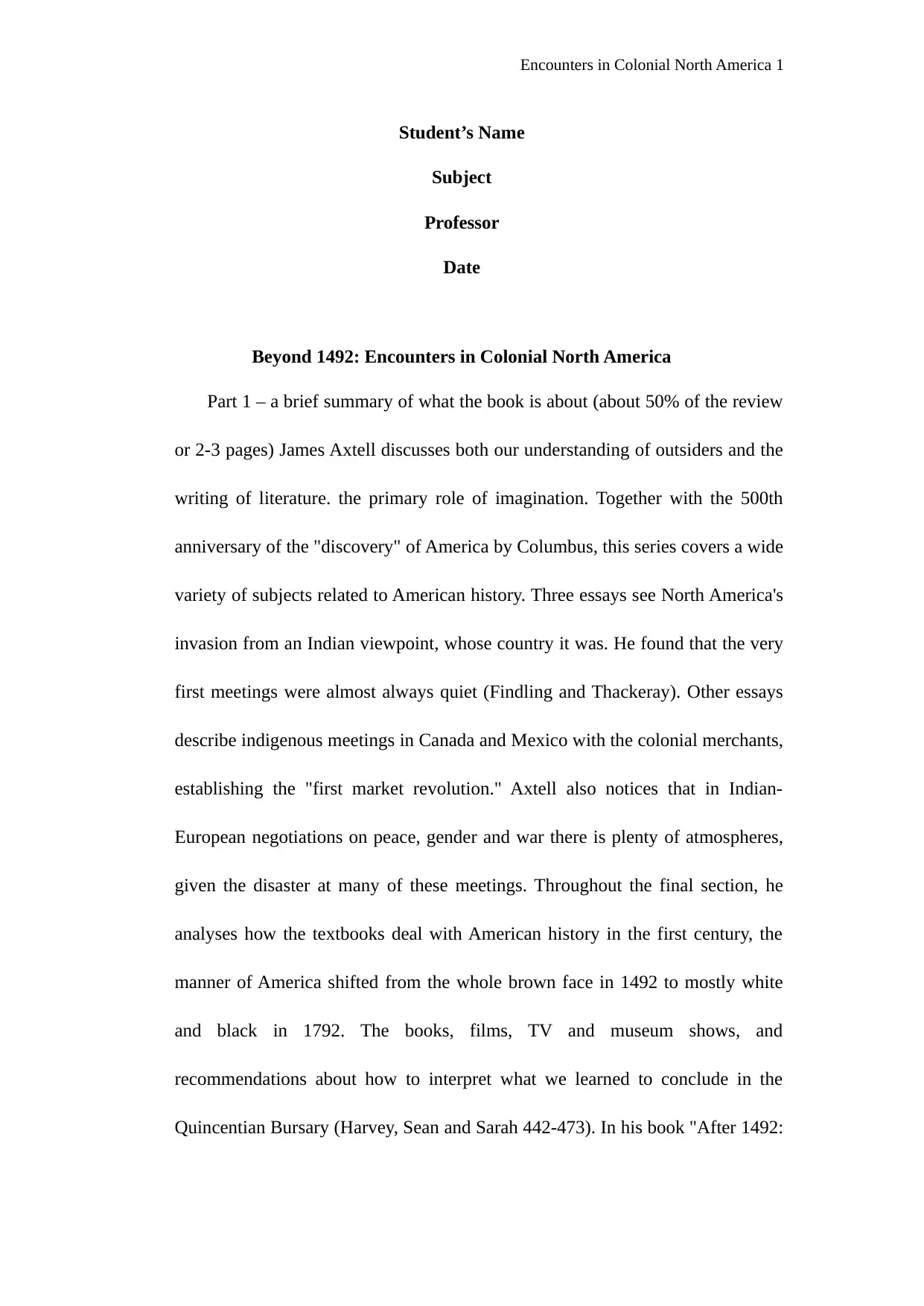
Encounters in Colonial North America 1
Student’s Name
Subject
Professor
Date
Beyond 1492: Encounters in Colonial North America
Part 1 – a brief summary of what the book is about (about 50% of the review
or 2-3 pages) James Axtell discusses both our understanding of outsiders and the
writing of literature. the primary role of imagination. Together with the 500th
anniversary of the "discovery" of America by Columbus, this series covers a wide
variety of subjects related to American history. Three essays see North America's
invasion from an Indian viewpoint, whose country it was. He found that the very
first meetings were almost always quiet (Findling and Thackeray). Other essays
describe indigenous meetings in Canada and Mexico with the colonial merchants,
establishing the "first market revolution." Axtell also notices that in Indian-
European negotiations on peace, gender and war there is plenty of atmospheres,
given the disaster at many of these meetings. Throughout the final section, he
analyses how the textbooks deal with American history in the first century, the
manner of America shifted from the whole brown face in 1492 to mostly white
and black in 1792. The books, films, TV and museum shows, and
recommendations about how to interpret what we learned to conclude in the
Quincentian Bursary (Harvey, Sean and Sarah 442-473). In his book "After 1492:
Student’s Name
Subject
Professor
Date
Beyond 1492: Encounters in Colonial North America
Part 1 – a brief summary of what the book is about (about 50% of the review
or 2-3 pages) James Axtell discusses both our understanding of outsiders and the
writing of literature. the primary role of imagination. Together with the 500th
anniversary of the "discovery" of America by Columbus, this series covers a wide
variety of subjects related to American history. Three essays see North America's
invasion from an Indian viewpoint, whose country it was. He found that the very
first meetings were almost always quiet (Findling and Thackeray). Other essays
describe indigenous meetings in Canada and Mexico with the colonial merchants,
establishing the "first market revolution." Axtell also notices that in Indian-
European negotiations on peace, gender and war there is plenty of atmospheres,
given the disaster at many of these meetings. Throughout the final section, he
analyses how the textbooks deal with American history in the first century, the
manner of America shifted from the whole brown face in 1492 to mostly white
and black in 1792. The books, films, TV and museum shows, and
recommendations about how to interpret what we learned to conclude in the
Quincentian Bursary (Harvey, Sean and Sarah 442-473). In his book "After 1492:
Secure Best Marks with AI Grader
Need help grading? Try our AI Grader for instant feedback on your assignments.
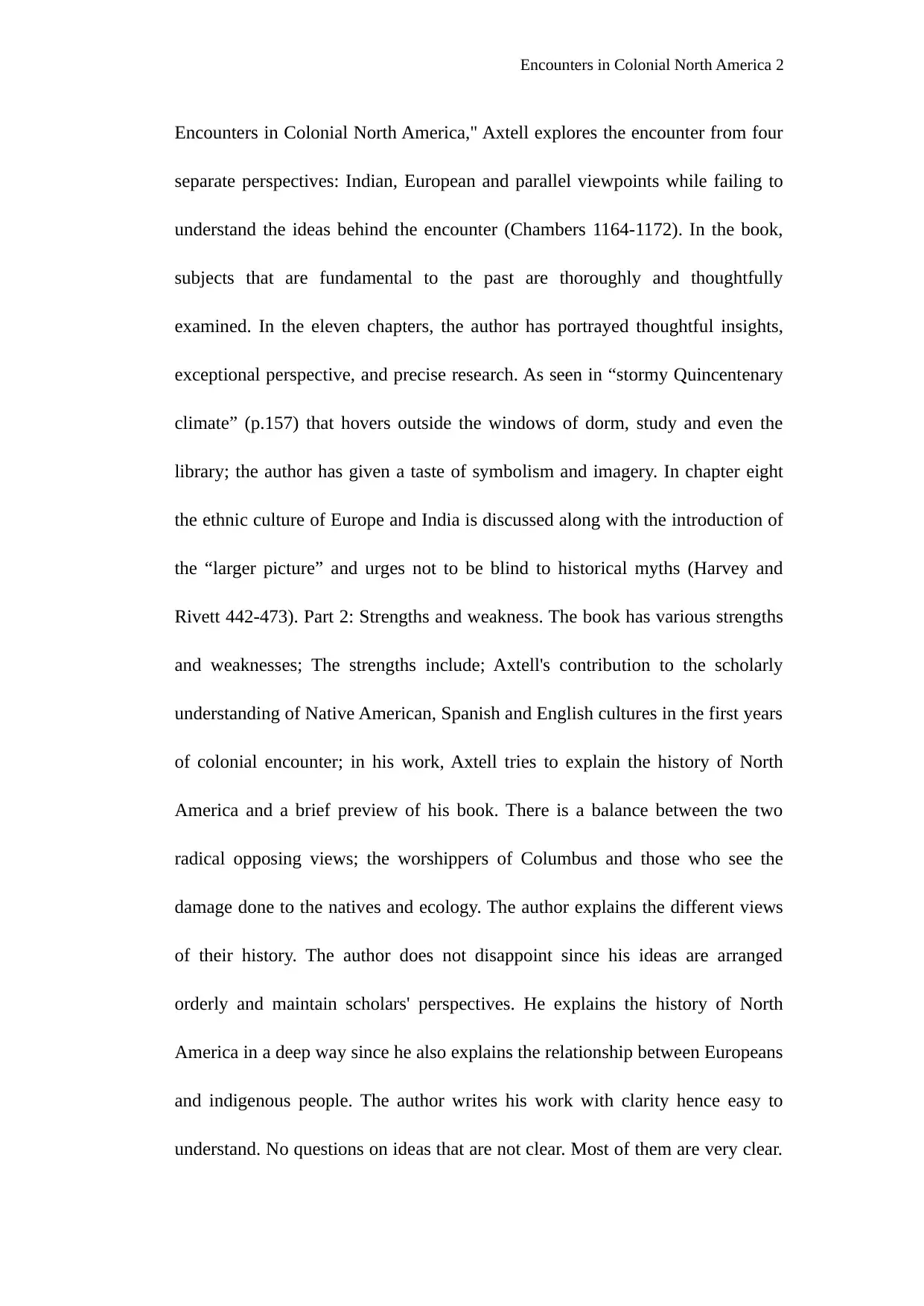
Encounters in Colonial North America 2
Encounters in Colonial North America," Axtell explores the encounter from four
separate perspectives: Indian, European and parallel viewpoints while failing to
understand the ideas behind the encounter (Chambers 1164-1172). In the book,
subjects that are fundamental to the past are thoroughly and thoughtfully
examined. In the eleven chapters, the author has portrayed thoughtful insights,
exceptional perspective, and precise research. As seen in “stormy Quincentenary
climate” (p.157) that hovers outside the windows of dorm, study and even the
library; the author has given a taste of symbolism and imagery. In chapter eight
the ethnic culture of Europe and India is discussed along with the introduction of
the “larger picture” and urges not to be blind to historical myths (Harvey and
Rivett 442-473). Part 2: Strengths and weakness. The book has various strengths
and weaknesses; The strengths include; Axtell's contribution to the scholarly
understanding of Native American, Spanish and English cultures in the first years
of colonial encounter; in his work, Axtell tries to explain the history of North
America and a brief preview of his book. There is a balance between the two
radical opposing views; the worshippers of Columbus and those who see the
damage done to the natives and ecology. The author explains the different views
of their history. The author does not disappoint since his ideas are arranged
orderly and maintain scholars' perspectives. He explains the history of North
America in a deep way since he also explains the relationship between Europeans
and indigenous people. The author writes his work with clarity hence easy to
understand. No questions on ideas that are not clear. Most of them are very clear.
Encounters in Colonial North America," Axtell explores the encounter from four
separate perspectives: Indian, European and parallel viewpoints while failing to
understand the ideas behind the encounter (Chambers 1164-1172). In the book,
subjects that are fundamental to the past are thoroughly and thoughtfully
examined. In the eleven chapters, the author has portrayed thoughtful insights,
exceptional perspective, and precise research. As seen in “stormy Quincentenary
climate” (p.157) that hovers outside the windows of dorm, study and even the
library; the author has given a taste of symbolism and imagery. In chapter eight
the ethnic culture of Europe and India is discussed along with the introduction of
the “larger picture” and urges not to be blind to historical myths (Harvey and
Rivett 442-473). Part 2: Strengths and weakness. The book has various strengths
and weaknesses; The strengths include; Axtell's contribution to the scholarly
understanding of Native American, Spanish and English cultures in the first years
of colonial encounter; in his work, Axtell tries to explain the history of North
America and a brief preview of his book. There is a balance between the two
radical opposing views; the worshippers of Columbus and those who see the
damage done to the natives and ecology. The author explains the different views
of their history. The author does not disappoint since his ideas are arranged
orderly and maintain scholars' perspectives. He explains the history of North
America in a deep way since he also explains the relationship between Europeans
and indigenous people. The author writes his work with clarity hence easy to
understand. No questions on ideas that are not clear. Most of them are very clear.
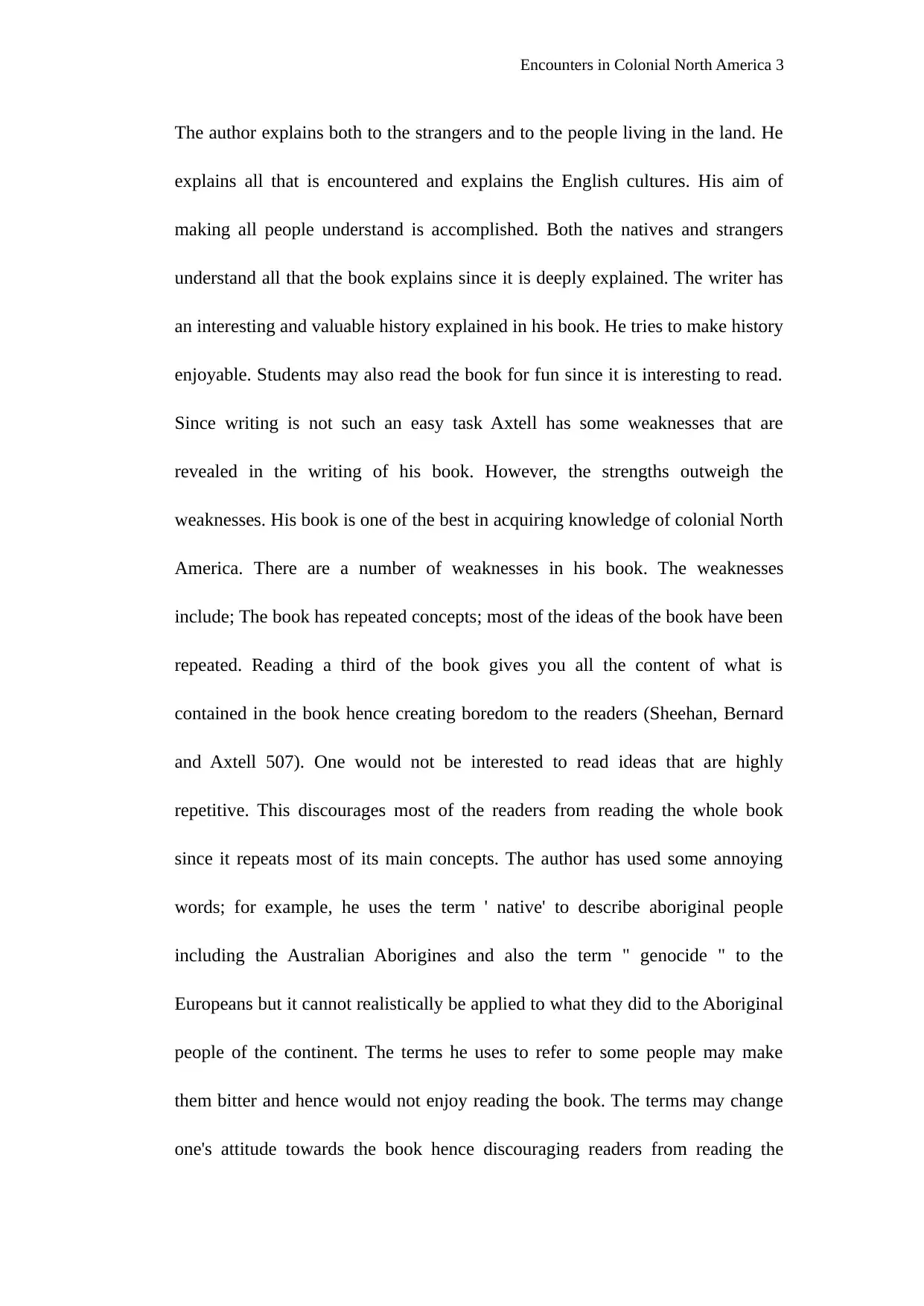
Encounters in Colonial North America 3
The author explains both to the strangers and to the people living in the land. He
explains all that is encountered and explains the English cultures. His aim of
making all people understand is accomplished. Both the natives and strangers
understand all that the book explains since it is deeply explained. The writer has
an interesting and valuable history explained in his book. He tries to make history
enjoyable. Students may also read the book for fun since it is interesting to read.
Since writing is not such an easy task Axtell has some weaknesses that are
revealed in the writing of his book. However, the strengths outweigh the
weaknesses. His book is one of the best in acquiring knowledge of colonial North
America. There are a number of weaknesses in his book. The weaknesses
include; The book has repeated concepts; most of the ideas of the book have been
repeated. Reading a third of the book gives you all the content of what is
contained in the book hence creating boredom to the readers (Sheehan, Bernard
and Axtell 507). One would not be interested to read ideas that are highly
repetitive. This discourages most of the readers from reading the whole book
since it repeats most of its main concepts. The author has used some annoying
words; for example, he uses the term ' native' to describe aboriginal people
including the Australian Aborigines and also the term " genocide " to the
Europeans but it cannot realistically be applied to what they did to the Aboriginal
people of the continent. The terms he uses to refer to some people may make
them bitter and hence would not enjoy reading the book. The terms may change
one's attitude towards the book hence discouraging readers from reading the
The author explains both to the strangers and to the people living in the land. He
explains all that is encountered and explains the English cultures. His aim of
making all people understand is accomplished. Both the natives and strangers
understand all that the book explains since it is deeply explained. The writer has
an interesting and valuable history explained in his book. He tries to make history
enjoyable. Students may also read the book for fun since it is interesting to read.
Since writing is not such an easy task Axtell has some weaknesses that are
revealed in the writing of his book. However, the strengths outweigh the
weaknesses. His book is one of the best in acquiring knowledge of colonial North
America. There are a number of weaknesses in his book. The weaknesses
include; The book has repeated concepts; most of the ideas of the book have been
repeated. Reading a third of the book gives you all the content of what is
contained in the book hence creating boredom to the readers (Sheehan, Bernard
and Axtell 507). One would not be interested to read ideas that are highly
repetitive. This discourages most of the readers from reading the whole book
since it repeats most of its main concepts. The author has used some annoying
words; for example, he uses the term ' native' to describe aboriginal people
including the Australian Aborigines and also the term " genocide " to the
Europeans but it cannot realistically be applied to what they did to the Aboriginal
people of the continent. The terms he uses to refer to some people may make
them bitter and hence would not enjoy reading the book. The terms may change
one's attitude towards the book hence discouraging readers from reading the
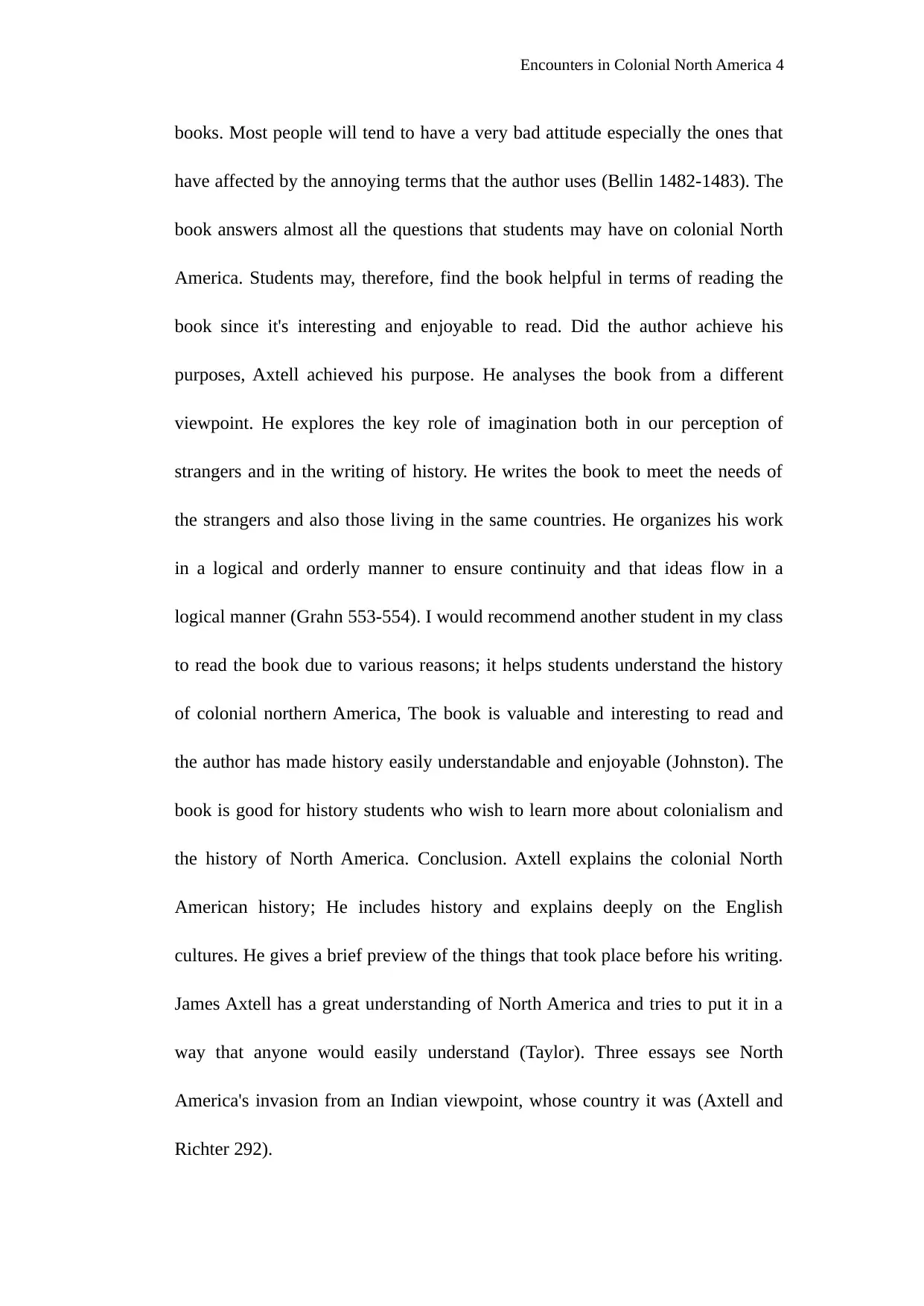
Encounters in Colonial North America 4
books. Most people will tend to have a very bad attitude especially the ones that
have affected by the annoying terms that the author uses (Bellin 1482-1483). The
book answers almost all the questions that students may have on colonial North
America. Students may, therefore, find the book helpful in terms of reading the
book since it's interesting and enjoyable to read. Did the author achieve his
purposes, Axtell achieved his purpose. He analyses the book from a different
viewpoint. He explores the key role of imagination both in our perception of
strangers and in the writing of history. He writes the book to meet the needs of
the strangers and also those living in the same countries. He organizes his work
in a logical and orderly manner to ensure continuity and that ideas flow in a
logical manner (Grahn 553-554). I would recommend another student in my class
to read the book due to various reasons; it helps students understand the history
of colonial northern America, The book is valuable and interesting to read and
the author has made history easily understandable and enjoyable (Johnston). The
book is good for history students who wish to learn more about colonialism and
the history of North America. Conclusion. Axtell explains the colonial North
American history; He includes history and explains deeply on the English
cultures. He gives a brief preview of the things that took place before his writing.
James Axtell has a great understanding of North America and tries to put it in a
way that anyone would easily understand (Taylor). Three essays see North
America's invasion from an Indian viewpoint, whose country it was (Axtell and
Richter 292).
books. Most people will tend to have a very bad attitude especially the ones that
have affected by the annoying terms that the author uses (Bellin 1482-1483). The
book answers almost all the questions that students may have on colonial North
America. Students may, therefore, find the book helpful in terms of reading the
book since it's interesting and enjoyable to read. Did the author achieve his
purposes, Axtell achieved his purpose. He analyses the book from a different
viewpoint. He explores the key role of imagination both in our perception of
strangers and in the writing of history. He writes the book to meet the needs of
the strangers and also those living in the same countries. He organizes his work
in a logical and orderly manner to ensure continuity and that ideas flow in a
logical manner (Grahn 553-554). I would recommend another student in my class
to read the book due to various reasons; it helps students understand the history
of colonial northern America, The book is valuable and interesting to read and
the author has made history easily understandable and enjoyable (Johnston). The
book is good for history students who wish to learn more about colonialism and
the history of North America. Conclusion. Axtell explains the colonial North
American history; He includes history and explains deeply on the English
cultures. He gives a brief preview of the things that took place before his writing.
James Axtell has a great understanding of North America and tries to put it in a
way that anyone would easily understand (Taylor). Three essays see North
America's invasion from an Indian viewpoint, whose country it was (Axtell and
Richter 292).
Secure Best Marks with AI Grader
Need help grading? Try our AI Grader for instant feedback on your assignments.
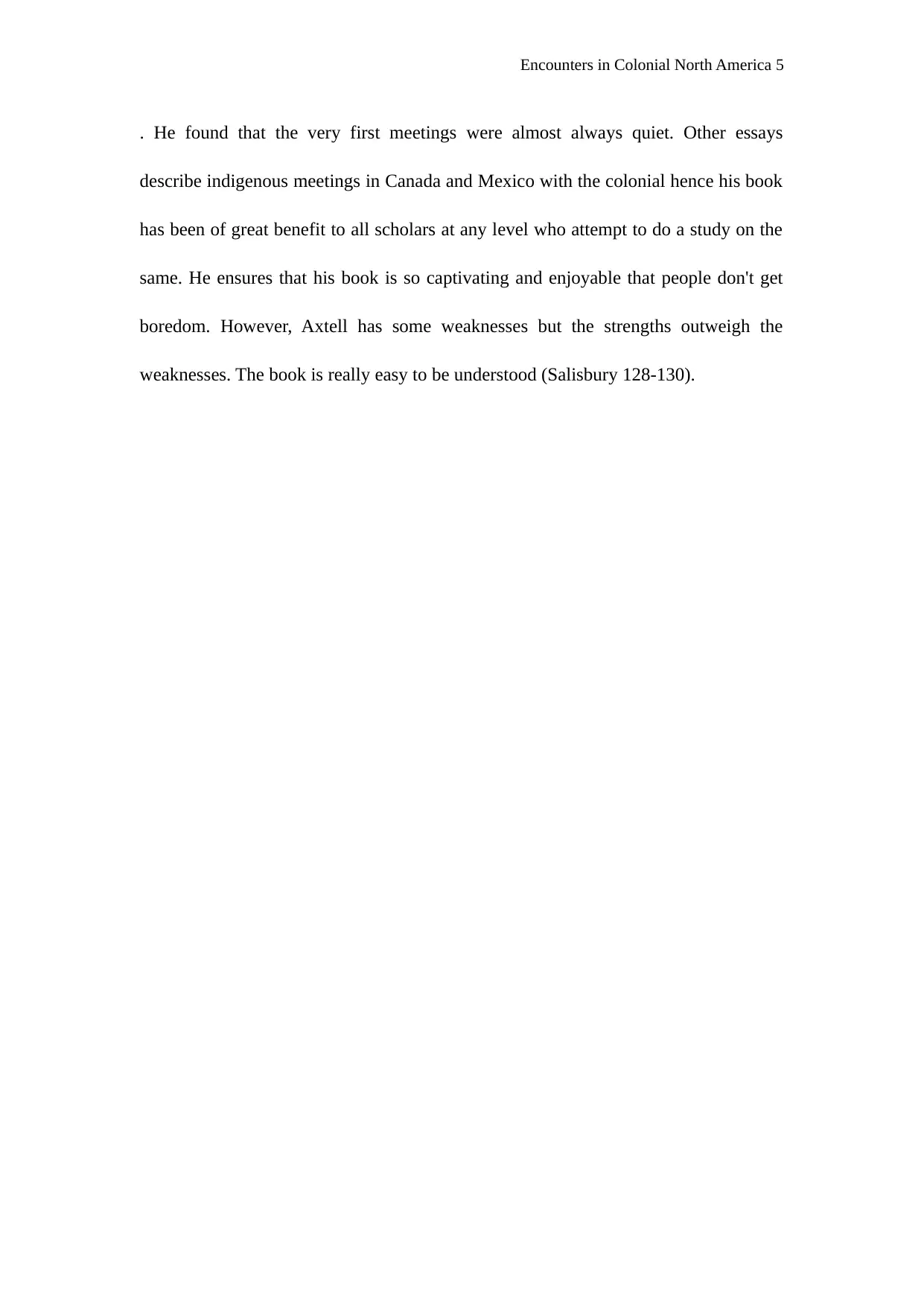
Encounters in Colonial North America 5
. He found that the very first meetings were almost always quiet. Other essays
describe indigenous meetings in Canada and Mexico with the colonial hence his book
has been of great benefit to all scholars at any level who attempt to do a study on the
same. He ensures that his book is so captivating and enjoyable that people don't get
boredom. However, Axtell has some weaknesses but the strengths outweigh the
weaknesses. The book is really easy to be understood (Salisbury 128-130).
. He found that the very first meetings were almost always quiet. Other essays
describe indigenous meetings in Canada and Mexico with the colonial hence his book
has been of great benefit to all scholars at any level who attempt to do a study on the
same. He ensures that his book is so captivating and enjoyable that people don't get
boredom. However, Axtell has some weaknesses but the strengths outweigh the
weaknesses. The book is really easy to be understood (Salisbury 128-130).

Encounters in Colonial North America 6
References
Axtell, James, and Daniel K. Richter. "James Axtell. <Italic>Beyond 1492:
Encounters In Colonial North America</Italic>. New York: Oxford University
Press. 1992. Pp. Xx, 376. $39.95." The American Historical Review 99.1 (1994):
292. Web. 11 Apr. 2020.
Bellin, Joshua David. ":Encounters Of The Spirit: Native Americans And
European Colonial Religion.(Religion In North America.)." The American
Historical Review 113.5 (2008): 1482-1483. Web.
Chambers, Ian. "Spatial Personas: A New Technique For Interpreting
Colonial Encounters In Colonial North America." History Compass 6.4 (2008):
1164-1172. Web.
Findling, John E, and Frank W Thackeray. Events That Changed America
Through The Seventeenth Century. Greenwood Pub. Group, 2000. Print.
Grahn, Lance. "Beyond 1492: Encounters In Colonial North America. By
James Axtell. (New York: Oxford University Press, 1992. Pp. Xx, 376. Maps.
Illustrations. Notes. Index. $39.95.)." The Americas 50.4 (1994): 553-554. Web.
11 Apr. 2020.
Harvey, Sean P., and Sarah Rivett. "Colonial-Indigenous Language Encounters In
North America And The Intellectual History Of The Atlantic World." Early American
Studies: An Interdisciplinary Journal 15.3 (2017): 442-473. Web.
References
Axtell, James, and Daniel K. Richter. "James Axtell. <Italic>Beyond 1492:
Encounters In Colonial North America</Italic>. New York: Oxford University
Press. 1992. Pp. Xx, 376. $39.95." The American Historical Review 99.1 (1994):
292. Web. 11 Apr. 2020.
Bellin, Joshua David. ":Encounters Of The Spirit: Native Americans And
European Colonial Religion.(Religion In North America.)." The American
Historical Review 113.5 (2008): 1482-1483. Web.
Chambers, Ian. "Spatial Personas: A New Technique For Interpreting
Colonial Encounters In Colonial North America." History Compass 6.4 (2008):
1164-1172. Web.
Findling, John E, and Frank W Thackeray. Events That Changed America
Through The Seventeenth Century. Greenwood Pub. Group, 2000. Print.
Grahn, Lance. "Beyond 1492: Encounters In Colonial North America. By
James Axtell. (New York: Oxford University Press, 1992. Pp. Xx, 376. Maps.
Illustrations. Notes. Index. $39.95.)." The Americas 50.4 (1994): 553-554. Web.
11 Apr. 2020.
Harvey, Sean P., and Sarah Rivett. "Colonial-Indigenous Language Encounters In
North America And The Intellectual History Of The Atlantic World." Early American
Studies: An Interdisciplinary Journal 15.3 (2017): 442-473. Web.
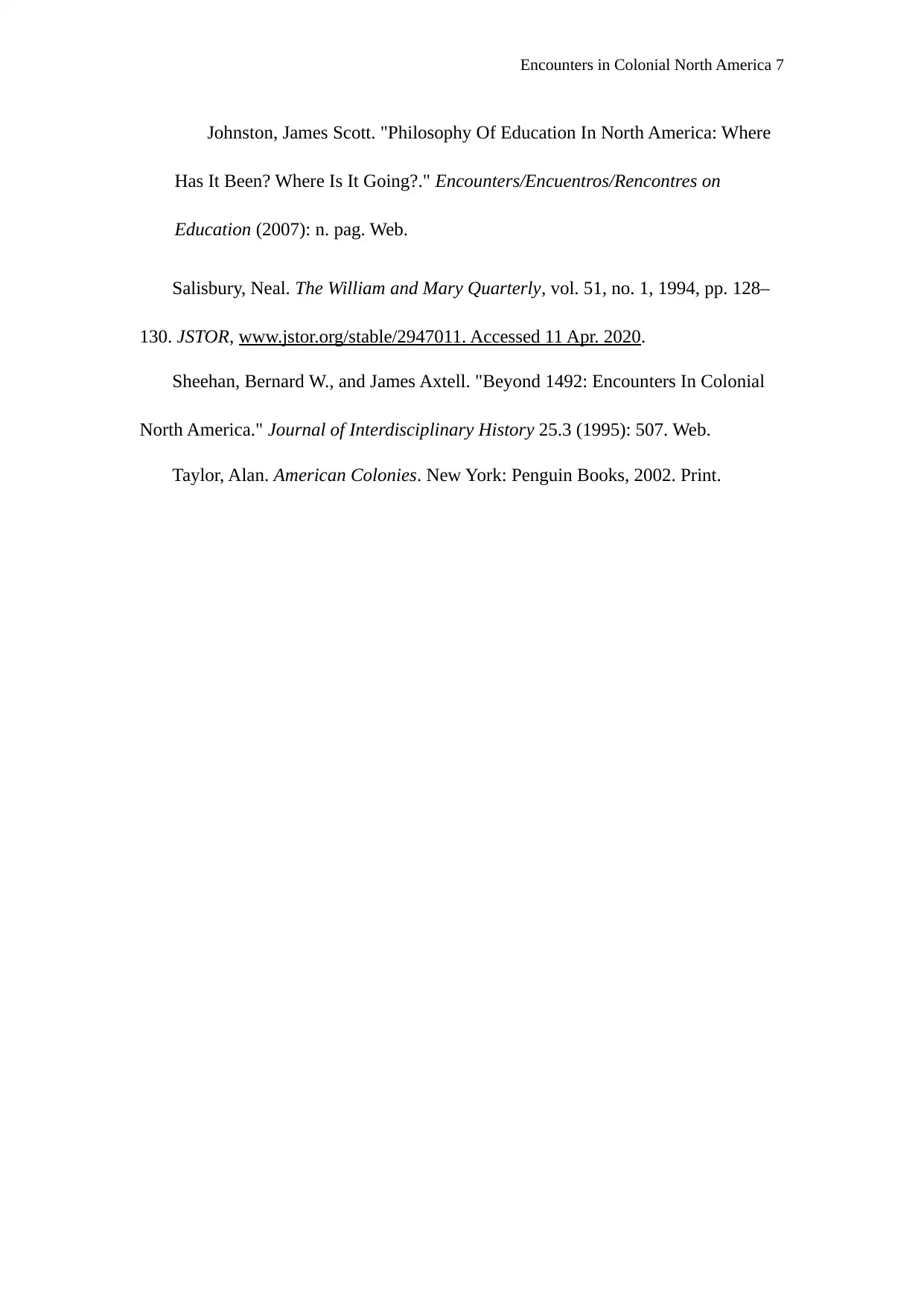
Encounters in Colonial North America 7
Johnston, James Scott. "Philosophy Of Education In North America: Where
Has It Been? Where Is It Going?." Encounters/Encuentros/Rencontres on
Education (2007): n. pag. Web.
Salisbury, Neal. The William and Mary Quarterly, vol. 51, no. 1, 1994, pp. 128–
130. JSTOR, www.jstor.org/stable/2947011. Accessed 11 Apr. 2020.
Sheehan, Bernard W., and James Axtell. "Beyond 1492: Encounters In Colonial
North America." Journal of Interdisciplinary History 25.3 (1995): 507. Web.
Taylor, Alan. American Colonies. New York: Penguin Books, 2002. Print.
Johnston, James Scott. "Philosophy Of Education In North America: Where
Has It Been? Where Is It Going?." Encounters/Encuentros/Rencontres on
Education (2007): n. pag. Web.
Salisbury, Neal. The William and Mary Quarterly, vol. 51, no. 1, 1994, pp. 128–
130. JSTOR, www.jstor.org/stable/2947011. Accessed 11 Apr. 2020.
Sheehan, Bernard W., and James Axtell. "Beyond 1492: Encounters In Colonial
North America." Journal of Interdisciplinary History 25.3 (1995): 507. Web.
Taylor, Alan. American Colonies. New York: Penguin Books, 2002. Print.
1 out of 7
Related Documents
Your All-in-One AI-Powered Toolkit for Academic Success.
+13062052269
info@desklib.com
Available 24*7 on WhatsApp / Email
![[object Object]](/_next/static/media/star-bottom.7253800d.svg)
Unlock your academic potential
© 2024 | Zucol Services PVT LTD | All rights reserved.





